Lightweight Membrane Materials
The research group is currently involved in several projects which aim to develop the use of coated fabrics and foils, aluminium, engineered timber and composites in the building industry.
The lightweight membrane materials are characterised and distinguishable through several aspects such as:
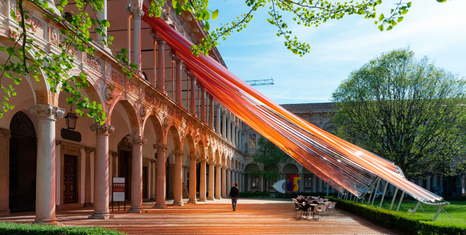
ETFE roof Maco Technology
- the intrinsic lightweight and efficient use of the materials
- reduced environmental impacts (especially when recyclable materials are used)
- cost-effective alternatives for flat or complex 3D surfaces
- good safety behaviour in case of fires or earthquakes
- a level of insulation (light, heat and noise)
Which can be progressively improved with specific surface treatments (Low-E coatings, reflective patterns, micro-perforated surfaces etc.) or additional insulating layers and materials.
Projects
Knowledge Transfer Partnership – KTP9912 (2015-2018)
Title: Knowledge Transfer Partnership to develop novel tensile membrane structures and adaptable textile-covered building facades.
Funder: InnovateUK
Total value: £174.952
Industrial Partner: Inside2Outside Ltd;
Years: 2015-2018
Summary:
The main challenge to be addressed by the partnership is the development of the products and manufacturing processes currently in use at Inside2Outside. Membrane structures are characterised by a high level of complexity which requires specialised engineering services and manufacturing processes which lead to increased costs and delivery times and a negative impact on the competitiveness.
The project aims to transform the current design and production process, which is mainly based on one-off structures designed by external consultants, into a more industrial approach based on modular structures which should maintain the architectural features and offer competitive and reliable solutions due to the use of standard components, advanced manufacturing techniques (software for Form-finding, structural analysis and cutting patterns, computerised cutting table etc.) and rapid estimation tools based on a parametric design approach.
A second challenge is to find new markets for the products which will be developed during the project. In addition to the improved quality and competitiveness obtained through the manufacturing processes, this challenge will require a detailed analysis of the market and the development of products which will satisfy the customers' needs and expectations in compliance with the current building regulations.
Finally, the full integration of flexible OPVs specifically into tensile membrane structures is the most promising and ambitious challenge addressed by the partnership. The use of flexible OPVs combined with tensile membrane structures is restrained by several technical aspects. The project aims to investigate the behaviour under load and develop manufacturing techniques which avoid the transfer of loads into the PV layer.
ACT members:
Key publications:
IBRAHIM ALI H., BECCARELLI P., REED V. and CARPENTER R., 2017, Performance of curved organic photovoltaics modules for membranes integration: solar simulation tests In: Structural membranes 2017 VIII International Conference on Textile Composites and Inflatable Structures, 9-11 October 2017, Munich, Germany.
IBRAHIM ALI H., BECCARELLI P., REED V. and CARPENTER R., 2017, Design of a cost effective small span tensile roof In: Structural membranes 2017 VIII International Conference on Textile Composites and Inflatable Structures, 9-11 October 2017, Munich, Germany.
IBRAHIM H., WAGDY A., BECCARELLI P., CARPENTER R. and CHILTON J., 2016. Applicability of Flexible Photovoltaic Modules onto Membrane Structures Using Grasshopper Integrative Model, Procedia Engineering. 155, 379-387.
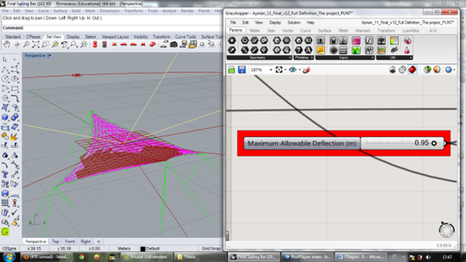
Flexible OPV Rhino Grasshopper allowable deflection value
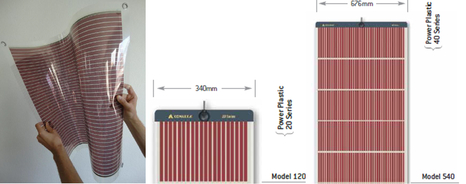
Konarka OPV modules Konarka power plastic
EU COST Programme Project TU1303
Title: EU COST Programme Project TU1303, Novel structural skins: Improving sustainability and efficiency through new structural textile materials and design.
Funder: EU COST Programme
Total value: : €674.130
Years: 2013-17
Summary:
The urban built environment is being transformed by building skins derived from textile architecture. Working from a basis of tensioned membranes, these highly efficient structural forms are now being integrated with multi-disciplinary technologies to form new multi-functional systems that address the needs and global challenges of the urban built environment.
The rapid emergence of lightweight building skins is in response to factors associated with climate change, energy, and workplace health and well-being, and is directly linked to advances in material development, analysis tools, and skills in design. These advances, led by European organisations, universities, companies, and SMEs, have, however, been somewhat fragmented. There is now a need to synthesise the current innovations and technologies from which to establish a platform on which the development of new advancements, products, and applications can be stimulated and produced.
The aim of the COST Action is to build a coalition of researchers, academics, architects, engineers, contractors, asset owners, and policy makers that create this platform. It will be achieved through the sharing of expertise, techniques, facilities and data, by establishing technical consensus, and developing European standardisation for the analysis, design, and realisation of multi-functional building skins.
By facilitating networking between partners and encouraging researcher mobility, this COST Action aims to harmonize the research on membrane and foil structural skins, to standardise testing and analysis approaches within Europe, and to stimulate and deliver innovation and development of new and energy efficient structural skin products and applications in the urban environment. The COST Action does not fund research itself but provides support for networking activities, such as meetings, short-term scientific missions, training schools, etc.
ACT members:
A new generation of temporary pavilions based on Tensairity girders
Title: A new generation of temporary pavilions based on Tensairity® girders
Industrial Partners: Tensairity Solutions srl;
Year: 2014-2018
Summary:
Tensairty® is a novel structural concept which consists of an air beam which is reinforced by a compression element and a tension element. The key principle of Tensairity® is to use low-pressure air of the air beam to prevent the compression element from buckling. The first developed Tensairity® structure had the shape of a cylindrical beam, where the inflated hull was reinforced with a strut and two helical cables. Further developments have resulted in spindle shaped Tensairity girders. The system has been successfully applied in several projects such as deployable and permanent bridges, permanent roofs, deployable structures and temporary pavilions.
In 2014 Tensairity Solutions Srl decided to establish a long term collaboration with the University of Nottingham in order to develop a new generation of temporary pavilions based on Tensairity® girders to be commercialised in the motorsport sector. The research led to an innovative type of structures which combine the lightness and simplicity of an air beam with the load bearing capacity of a truss structure. The result is an attractive design, with light and aerodynamic girders which can be integrated with LED lights and sensors in order to enhance the impact on the users and adapt the structure to the environmental conditions.
After four years the system has been successfully used in the main motorsports events and became the new paradigm for this market. The list of the current users of a Tensairity® pavilion includes Yamaha MotoGP, Ducati Superbike, Imperiale-Lamborghini Blancpain GT Series, Audi Tron Sailing Series and ISAF Sailing WorldCup.
ACT members:
Key publications:
BECCARELLI P., MAFFEI R., GALLIOT C. and LUCHSINGER R.H., 2015. A new generation of temporary pavilions based on Tensairity® girders Steel Construction. 8(4), 259-264
BECCARELLI P., MAFFEI R., LUCHSINGER R.H. and CHILTON J., 2015. Ducati Superbike Pavilion: Design and Manufacturing of a Tensairity® Roof In: Structural membranes 2015 VII International Conference on Textile Composites and Inflatable Structures, 19-722 October 2015, Barcellona, Spain
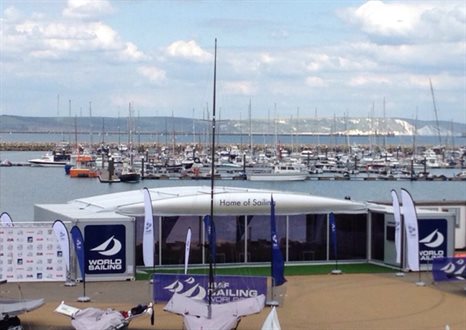
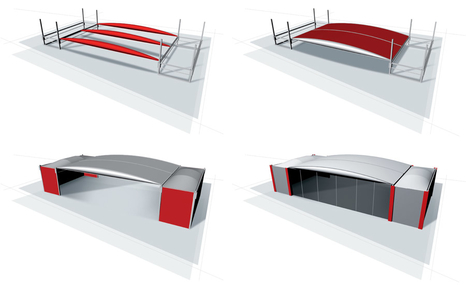
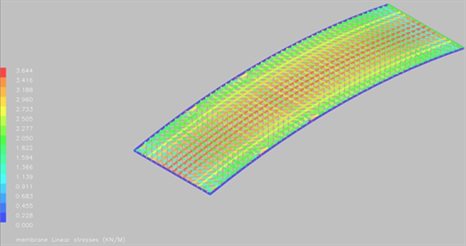
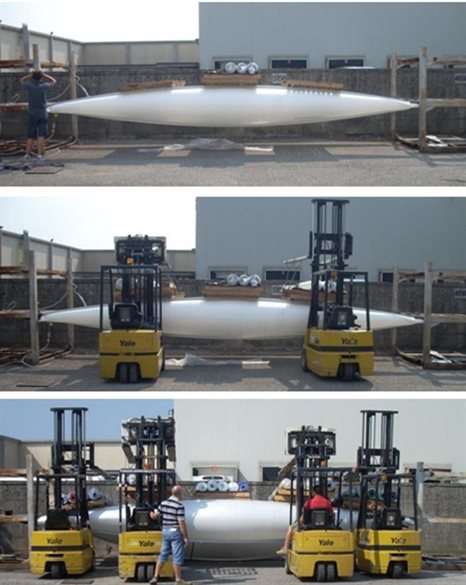
The optimisation of aluminium structures for temporary pavilions
Title: The optimisation of aluminium structures for temporary pavilions
Industrial Partners: Linko Resources Ltd, Maco Technology srl;
Years: 2015-2017
Summary:
Linko Resources Ltd is a company based in London leader in the organization of events for the motorsport sector. Due to the growing demand for structures which balance the iconic architectural appeal with the increasing restrictions in terms of health and safety, time and space for the installation, transportation volume and budget, Linko Resources Ltd decided to develop a new generation of temporary structures for the events organized in conjunction with the motorsport races.
Maco Technology srl and the University of Nottingham have been appointed to design a new temporary pavilion to be connected to a standard 13m x 2.5m truck and optimized for the rapid installation through un-experienced workers according to the current best practice and framework of European norms in terms of structural design and installation of temporary structures.
The successful collaboration resulted in a new set of five structures currently in use and paved the way for a new innovative generation of aluminium structures characterised by the advanced 3D digital modelling of each component, the structural optimisation of profiles and connections, the optimisation of the transportation volumes and the improvement of the installation procedures
ACT members:
Key publications:
BECCARELLI P. and MAFFEI R., 2016. Design and Manufacturing of the Linko Demountable Fabric Pavilion for the Motorsport Sector Procedia Engineering. 155, 323-331

Linko Hospitality pavilion structural model
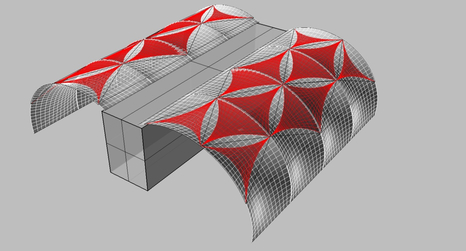
Linko Hospitality pavilion 3D model
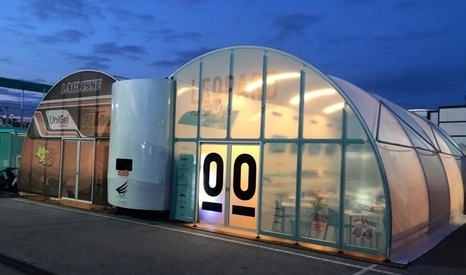
Linko Hospitality pavilion
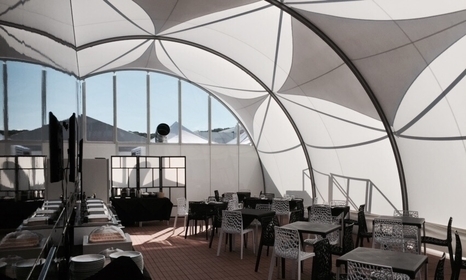
Linko Motor Home interior
Title: “Off The Cuff” pavilion, FuoriSalone 2017, Milan
Industrial Partners: Mosca Partners & Damn° , Diller Scofidio + Renfro, Thornton Tomasetti, Maco Technology, L’Observatoire International, Emeco, Eterno Ivica, Gaggenau, Living Divani, Trussardi, Zumtobel, Redaelli Tecna, F.lli Giovanardi;
Year: 2017
Summary:
The 2017 edition of ‘A Matter of Perception’ saw Mosca Partners and DAMN° return to Palazzo Litta during Milan Design Week together again with some of the most interesting protagonists in international design.
One of the most awaited events in the Fuorisalone’s busy programme of happenings taking place in the 5VIE design district is the exhibition at Palazzo Litta. The building itself being a fascinating example of Lombard Baroque architecture in the city and an expression of the connection between Milanese culture and the French and English Enlightenment.
The third edition of the ‘A Matter of Perception’ exhibition explored the theme of LINKING MINDS. Very often good ideas are generated by closed encounters and long lasting collaborations. The goal was to create an exhibition that lends into the creative process between two or more persons. Ideas that grow from scratch through a mix of friendship, mutual trust and experience. Resulting in a wonderful final project.
The main installation of the exhibition was “Off The Cuff” pavilion designed by Diller Scofidio + Renfro. The roof canopy was composed of 300 pairs of jeans. DS+R deploys the jeans as ready-mades, intentionally misusing and translating them from the context of the human body into an architectural module. The design exploits the implicit structural logic of the jeans – connecting them waist-to-waist and cuff-to-cuff to create a tensile, catenary diagrid that spans the open space of the courtyard. The net gives the impression of a body imprinted in space, but one also defamiliarised by repetition. As an architectural figure, the net springs across the courtyard, describing a collective ethos; as a series of modular parts, the jeans point to the individual human dimension. A contemporary folly in the bracketed context of monumental classicism, the canopy stitches together two vital scales of urban life.
Maco Technology srl as main contractor and the University of Nottingham as structural consultant, worked as project managers for the pavilion supporting DS+R from the progressive development of the initial idea to the fabrication and installation of the pavilion. The tasks included the refining the preliminary engineering design done by Thornton Tomasetti, the development of the connections, the optimisation the installation procedures and the selection of the suppliers.
ACT members:
Key publications:
BECCARELLI P. and MAFFEI R., 2017, Engineering and Fabrication of the “Off The Cuff” pavilion, FuoriSalone 2017, Milan In: Structural membranes 2017 VIII International Conference on Textile Composites and Inflatable Structures, 9-11 October 2017, Munich, Germany.
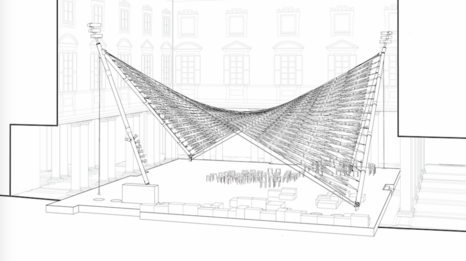
Diller Scofidio Renfro Milan Design Week 2017
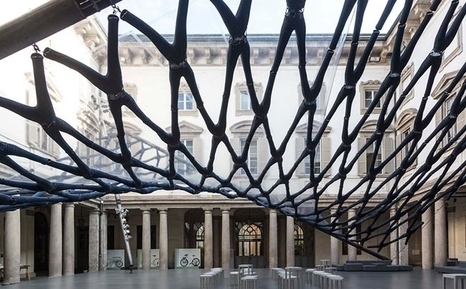
Off the cuff jean canopy palazzo litta milan cortile maco-technology
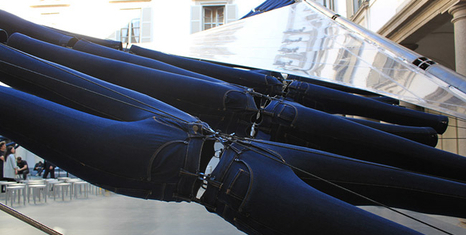
Jeans maco technology
Title: “Invisible Borders” pavilion, FuoriSalone 2017, Milan
Industrial Partners: Ma Yasong – MAD Architects, Maco Technology srl, Ferrarelle spa, P.A.T.I. spa, iGuzzini;
Year: 2016
Summary:
The “Invisible Border” pavilion, designed by MAD Architects for the Salone del Mobile 2016, represented a unique opportunity to investigate the potential of digital printing on an ETFE foil thanks to the collaboration with Maco Technology and the support of Ferrarelle, P.A.T.I. and iGuzzini. The project is based on strips of ETFE plastic stretched from the main internal façade of the University of Milan’s headquarter.
[The installation represents a sculptural gesture that is inserted to break the balance of the Cortile d’Onore and at the same time establish a new shelter, between the façade and the courtyard, for people to engage in discussions or just contemplate the sky through the canopy. The result is an installation, inspired by natural flow of wind and water, which extends the physical and conceptual threshold of a boarder.] (www.i-mad.com)
In order to achieve the expected architectural impact, the architect required a unique treatment of the ETFE foil designed to catch and reflect the sunshine on the main façade, in the courtyard and underneath the temporary installation. The result is a colourful undulated surface moved by the wind which offers a unique opportunity for the visitors to glimpse the sky through the translucent material and the thin gaps between the strips and enjoy the shading for the sunlight. The effect was emphasized by the gradient of the printed strips characterised by a progressive increase in the level of translucency made possible by the digital printing technology developed by P.A.T.I. in the recent years.
The pilot project paved the way for new architectural applications of digitally printed ETFE foils which are currently under development within a long term research collaboration between P.A.T.I. spa, Maco Technology srl and the University of Nottingham
ACT members:
Key publications:
BECCARELLI P., MAFFEI R. and BINDA R., 2016. ETFE envelopes for the building sector In: Proceedings of the 11th Conference on Advanced Building Skins. 720-729
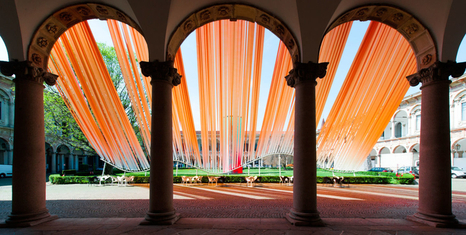
ETFE interni open borders 2016
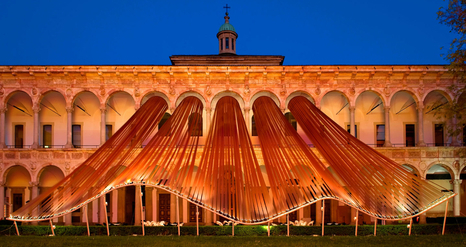
ETFE night lights maco technology

ETFE roof Maco Technology
Knowledge Transfer Partnership – KTP9213 (2013-2015)
Title: Knowledge Transfer Partnership to design, develop and implement a modular self-supporting structural-construction system comprised of linked ETFE foil encapsulated panels.
Funder: InnovateUK
Total value: £124.235
Industrial Partner: Holscot Fluoroplastics Limited;
Years: 2013-2015
Summary:
Holscot has devised and patented a novel approach using ETFE in panel structures, which could replace glass. Existing markets for ETFE roof structures use air filled cushions which require air-pumps to maintain the pressure, a good example of this is the Eden Project. The inherent problems with cushions are that they are air inflated and must never lose pressure and that the cushions must be fitted on site by very skilled climbers. These factors make the ETFE cushions very expensive.
The new Holscot panel is conventionally designed and currently based on an aluminium frame. Similar to glass, the panels can be fitted by conventional labour, but if punctured or damaged, the Holscot ETFE panels do not deflate and therefore can be repaired or replaced by conventional labour.
The KTP presented a strategic opportunity to develop a product which enables clients to build structures that require a light weight, more flexible solution to glass.
The KTP support the development of the existing panel by providing necessary expertise on system design and meeting the required specifications and industry/market standards. In addition, during the KTP project, the team of researchers involved designed and developed a new system of ETFE encapsulated modular panels which can be easily joined together to form a self-supporting, integral structure.
ACT members:
Key publications:
B. A. J. MARTIN, B. LAU, P. BECCARELLI, Y. WU and J. CHILTON, 2015. Modular Transparent ETFE Panels for Building Envelopes: Thermal Transmittance Assessment and Evaluation IASS 2015 Symposium and Pavilion Contest.
BECCARELLI P., MARTIN B., LAU B., CHILTON J., BONARDI S. and MAFFEI R., 2015. Single-board microcontrollers applied to biaxial tests for architectural membranes In: International IASS Symposium 2015, 17-20 August, Amsterdam, Netherlands.
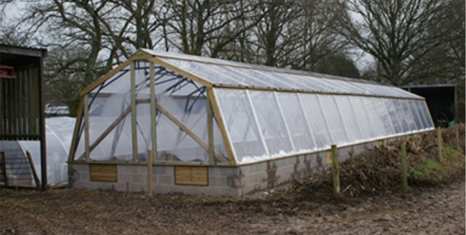
ETFE green house Nottingham University

ETFE modular panel installation
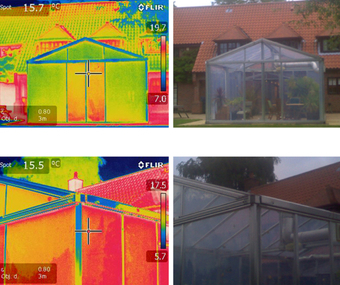
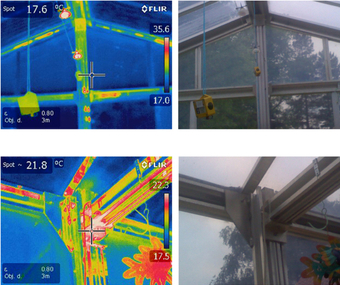
ETFE panel thermal imaging camera
Economy Festival Pavilions 2016 & 2017
Title: Tectonics of pneumatic structures: The pavilions for the Trento Economics Festival 2016 & 2017
Industrial Partners: Monica Armani, Maco Technology srl;
Years: 2016 - 2017
Summary:
After the successful collaboration for the engineering and detailing of the pneumatic façade of the RCS pavilion for EXPO 2015, the architect and designer Monica Armani contacted Maco Technology srl and the University of Nottingham in order to develop an innovative concept based on pneumatic structures for the Trento Economics Festival.
The client set challenging requirements in terms of overall architectural appeal, installation time and costs, weight of the components, packaging volumes and environmental impact of the structure. The team of researchers from the University of Nottingham contributed to the project providing the expertise about the 3D digital form finding, the structural design and the generation of the cutting pattern for the pneumatic membrane envelope.
The collaboration resulted in two pavilions, based on steel and timber portals coved with and inflated pneumatic roof, for the Trento Economics Festival 2016 and three pavilions covered by an inflatable structural slab filled with air for the 2017 edition.
ACT members:
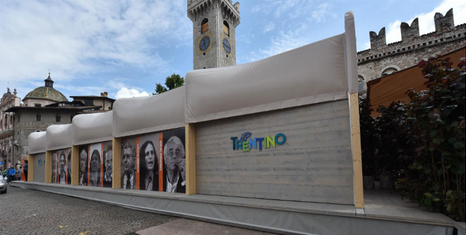
2016 poneumatic roof timber gluelam PVC
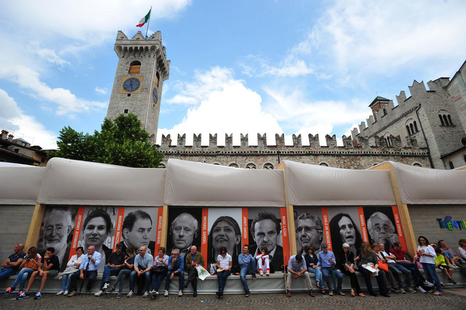
Economic festival 2016 Trentino
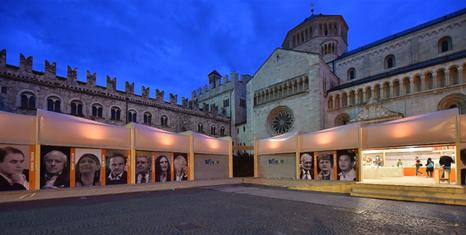
Membrane pavilion
- Bending Active Structures - PhD Mahdi
- Emergency Bridges based on Tensairity girders
Key contacts